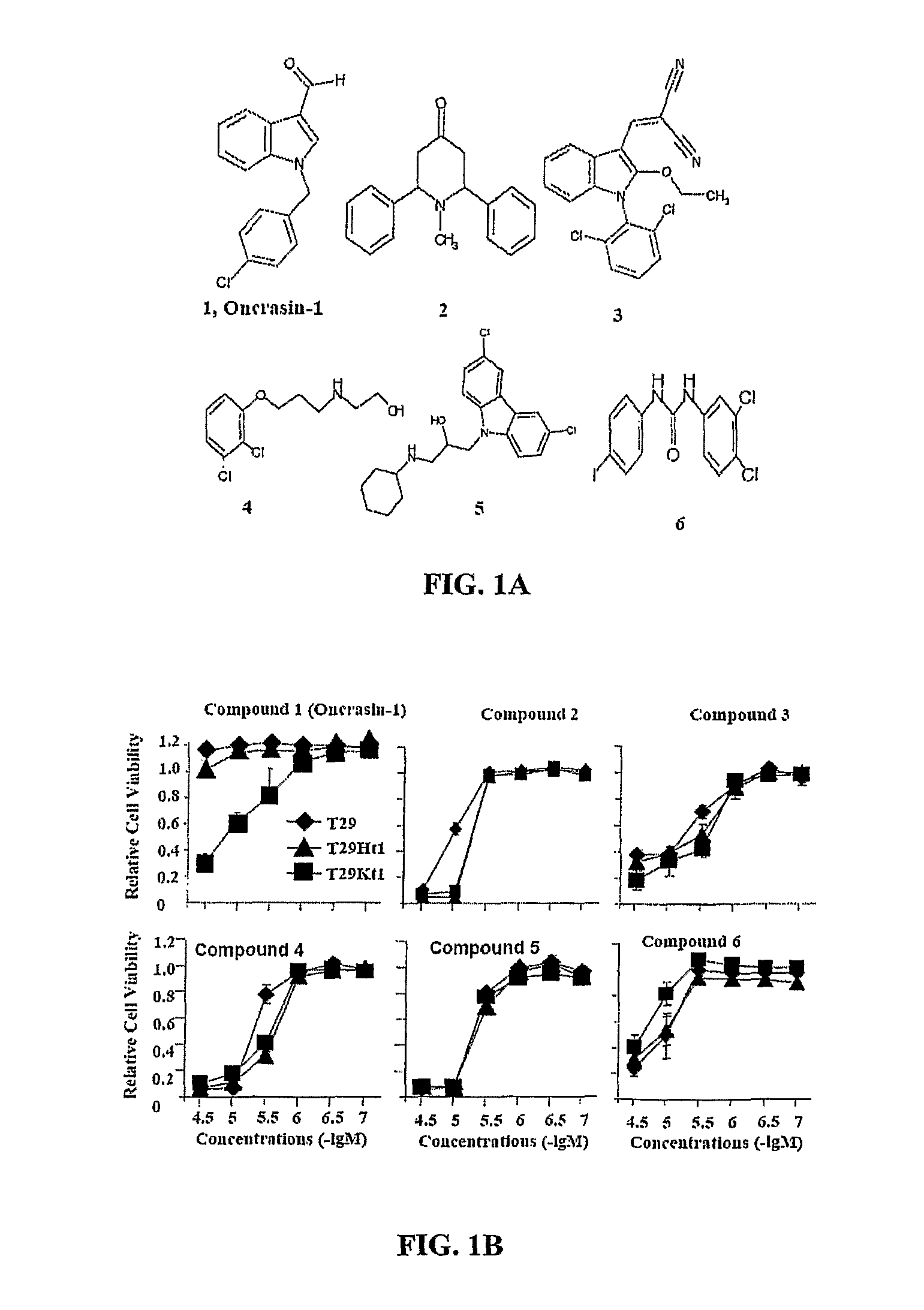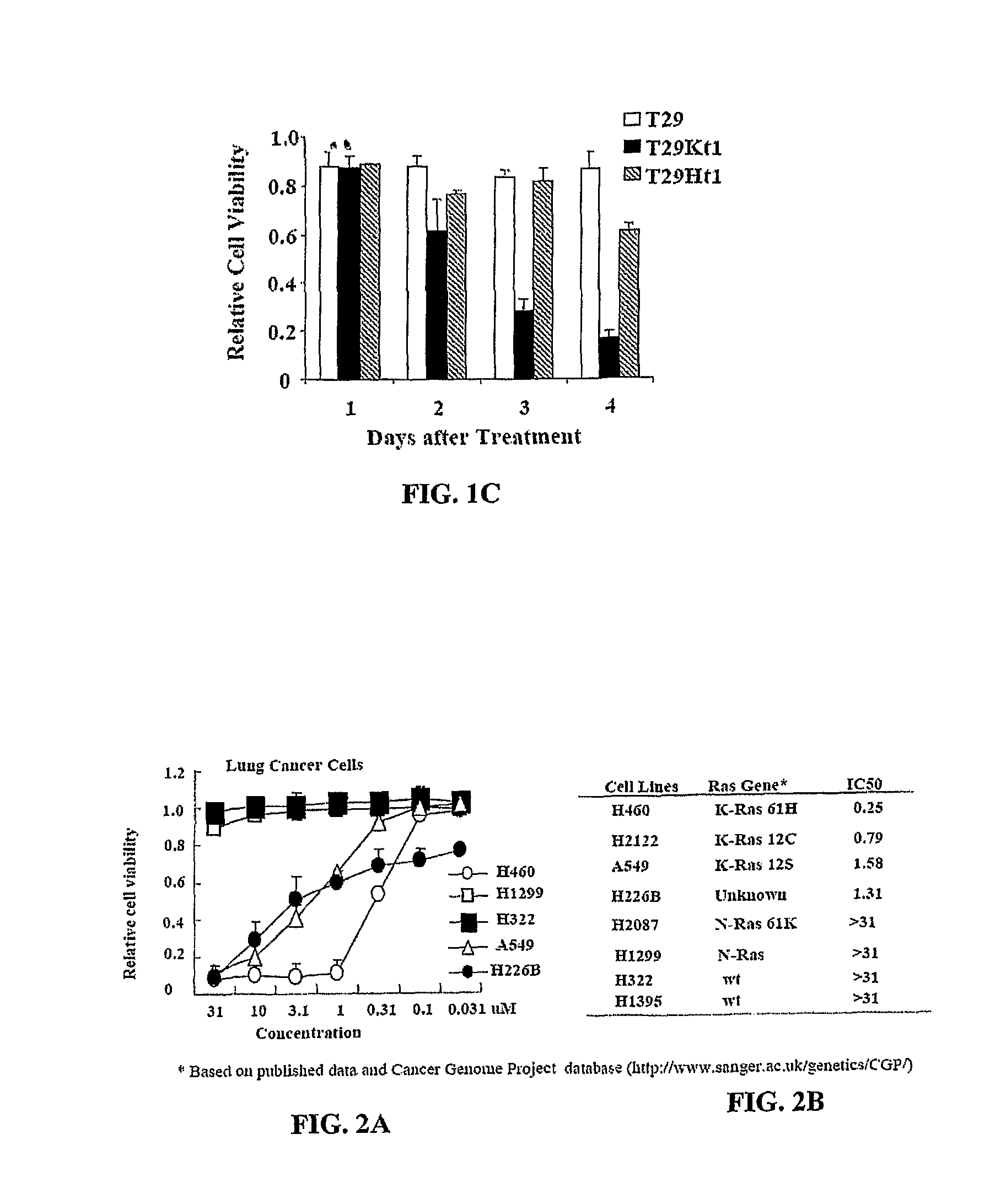Oncogenic ras-specific cytotoxic compound and methods of use thereof
a cytotoxic compound and oncogenic technology, applied in the field of cancer treatment, can solve the problems of abnormal intracellular distribution of atypical protein kinase c iota (kcl), and achieve the effect of reducing phosphorylation
- Summary
- Abstract
- Description
- Claims
- Application Information
AI Technical Summary
Benefits of technology
Problems solved by technology
Method used
Image
Examples
example 1
Identification and Characterization of Oncrasins Family of Compounds
[0237]Library screening for oncogenic Ras-targeted compounds To screen for compounds that can specifically kill tumor cells but not their normal counterparts, T29, T29Kt1, and T29Ht1 cells were treated in parallel with compounds in a diverse chemical library obtained from Chembridge Corporation. T29 cells are normal human ovarian surface epithelial cells immortalized with the catalytic subunit of human telomerase reverse transcriptase and the SV40 early genomic region. (Liu et al., 2004) T29Ht1 and T29Kt1 cells were derived from tumors that were established from T29 cells stably transfected with oncogenic H-Ras and K-Ras, respectively, (Liu et al., 2004) and were highly tumorigenic. Cells seeded in a 96-well plate were treated with each compound at a final concentration of about 5 μg / mL (about 20-30 μM). Cells treated with solvent (dimethyl sulfoxide, DMSO) were used as controls. A lethal effect was determined in a ...
example 2
Oncrasin and Oncrasin Analogs
[0249]The inventors submitted two compounds, Oncrasin-27 and Oncrasin-60 to the National Cancer Center (NCI) for testing in a panel of 60 cancer cell lines derived from various tissues or organs. The tests performed at NCI showed that Oncrasin-27 and Oncrasin-60 had similar anticancer spectrum and were active in a number of cancer cell lines derived from leukemia, non small lung cancer, colon cancer, melanoma, ovarian cancer, renal cancer and breast cancer (see Table 3A and 3B). For example, of 54 cell cancer cell lines tested, the medium 50% growth inhibition (GI50) concentration for Oncrasin-60 is 1.12 μM. 17 cell lines (31%) have GI5050 below 0.1 μM; 5 cell lines (9.3%) have GI50<10 nM. Those results demonstrated that Oncrasin compounds could be effective against a variety of cancers with high potency. According to gene mutation data for NCI 60 cancer cell lines (sanger.ac.uk / genetics / CGP / NCI60 / ), the inventors compared gene mutations in the sensitive...
example 3
IN VIVO Activity of Oncrasin Compounds
[0254]The inventors have investigated the in vivo antitumor activity of Oncrasin compounds, such as Oncrasin-1 and Oncrasin-27, both are available at relatively larger scale. Subcutaneous tumors were established in 4- to 6-week-old female nude mice (Charles River Laboratories Inc., Wilmington, Mass.) by the inoculation of 1.5×106 H460 cells into the dorsal flank of each mouse. After the tumors grew to 5 mm in diameter, mice were treated with intraperitoneal injections of Oncrasin-1 (for 10 days) or Oncrasin-27 (for 3 days, because of limited availability of the compound) at a dose of 100 mg / kg / injection daily (the agents were dissolved in 0.5 mL of solvent containing 10% DMSO, 10% Cremophor EL, and 10% ethanol), or they were given intraperitoneal injections of solvent alone. The tumor volumes were calculated using the formula a×b2×0.5, where a and b represent the larger and smaller diameters, respectively (Gu et al., 2000; Terashi et al., 2005)....
PUM
| Property | Measurement | Unit |
|---|---|---|
| concentrations | aaaaa | aaaaa |
| body weight | aaaaa | aaaaa |
| body weight | aaaaa | aaaaa |
Abstract
Description
Claims
Application Information
 Login to View More
Login to View More - R&D
- Intellectual Property
- Life Sciences
- Materials
- Tech Scout
- Unparalleled Data Quality
- Higher Quality Content
- 60% Fewer Hallucinations
Browse by: Latest US Patents, China's latest patents, Technical Efficacy Thesaurus, Application Domain, Technology Topic, Popular Technical Reports.
© 2025 PatSnap. All rights reserved.Legal|Privacy policy|Modern Slavery Act Transparency Statement|Sitemap|About US| Contact US: help@patsnap.com



